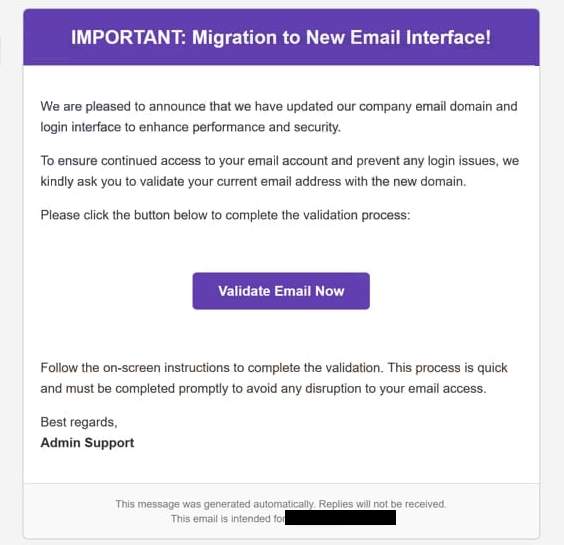Remove “Migration To New Email Interface” email
The “Migration To New Email Interface” email is a phishing scam that intends to steal your email login credentials. It falsely informs you that the company has updated its email domain and login interface to enhance performance and security. The email asks that you validate your email address with the new domain. However, this email is malicious, and clicking on any links within it directs you to a phishing website aimed at capturing your email login information. If login credentials are entered on this phishing site, your account may be hijacked by the malicious actors behind this phishing campaign.
According to the “Migration To New Email Interface” email, your company has updated its email domain, which is why you are asked to validate your email by clicking on the provided link. However, the link directs users to a phishing website designed to steal email login credentials. This phishing site is a poor imitation of Gmail. The site will show a window asking you to provide your gmail.com password to access secure settings. If you fall for this phishing attempt and enter your password, the credentials will be immediately sent to the cybercriminals behind the campaign. These malicious actors could exploit the stolen credentials themselves or sell them to others for criminal purposes.
Email login credentials are particularly valuable to cybercriminals, as email accounts often store sensitive information and are linked to numerous other accounts. Thus, unauthorized access can allow hackers to take control of connected accounts if they reset their passwords. Furthermore, private or sensitive data contained in emails could be used for blackmail. It is therefore essential for you to be extremely careful with your email login credentials.
The full text from the “Migration To New Email Interface” phishing email is below:
Subject: Important: Validate Your Email for the New Interface Upgrade
IMPORTANT: Migration to New Email Interface!
We are pleased to announce that we have updated our company email domain and login interface to enhance performance and security.
To ensure continued access to your email account and prevent any login issues, we kindly ask you to validate your current email address with the new domain.
Please click the button below to complete the validation process:
Validate Email NowFollow the on-screen instructions to complete the validation. This process is quick and must be completed promptly to avoid any disruption to your email access.
Best regards,
Admin Support
This message was generated automatically. Replies will not be received.
This email is intended for -.Unsubscribe – Unsubscribe Preferences
What are the signs of a phishing email
Many phishing campaigns tend to be quite generic and thus easy to identify, and the “Migration To New Email Interface” email is a good example of this. Because some malicious campaigns tend to target many users with the same exact email, the emails are very generic and do not contain any credible information. Phishing attempts directed at specific, high-profile individuals or organizations tend to be more sophisticated and harder to detect. However, most people are more likely to receive these generic phishing emails since they are not specifically targeted.
Note that you are not addressed in the “Migration To New Email Interface” email in any way. This makes the malicious intent very clear. Legitimate emails from any service providers always address users by the names associated with their accounts. If an email uses generic words like User, Member, or Customer, or if it completely omits a greeting, it is a strong indication of a phishing/malicious attempt.
The sender’s email address can also tell you a lot about whether the email is legitimate. While some email addresses may look suspicious right away (usually a sign of a low-effort phishing attempt), others can be made to appear legitimate and trustworthy. A quick online search may help determine if the email address is genuine and belongs to the claimed sender. However, it should be noted that attackers might spoof a user’s own email address, making it seem as if the message came from their account when that is not the case.
Another warning sign of phishing emails is grammar and spelling mistakes. Legitimate emails are generally well-written, whereas low-quality phishing attempts often have numerous mistakes. Even if an email appears polished, users should be on the lookout for awkward phrasing or unusual sentence structures.
It’s strongly recommended to avoid clicking on links in emails altogether. If an email indicates an issue with your account, it’s best to access the account manually rather than clicking on an email link. Lastly, you should always check a site’s URL before you log in.
Remove “Migration To New Email Interface” phishing email
The “Migration to New Email Interface” email can be safely disregarded and deleted. However, if you have clicked on any links or entered your login credentials, you need to change your password immediately if you still have access to your account. To protect other accounts, you should unlink any connected accounts if you can no longer access your email account.
Site Disclaimer
WiperSoft.com is not sponsored, affiliated, linked to or owned by malware developers or distributors that are referred to in this article. The article does NOT endorse or promote malicious programs. The intention behind it is to present useful information that will help users to detect and eliminate malware from their computer by using WiperSoft and/or the manual removal guide.
The article should only be used for educational purposes. If you follow the instructions provided in the article, you agree to be bound by this disclaimer. We do not guarantee that the article will aid you in completely removing the malware from your PC. Malicious programs are constantly developing, which is why it is not always easy or possible to clean the computer by using only the manual removal guide.

